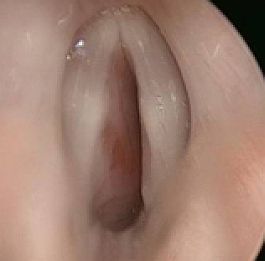 Las lesiones neoplásicas congénitas son siempre benignas y la más frecuente es el angioma subglótico. Se trata de angiomas capilares inmaduros que no están todavía presentes en el momento del nacimiento sino que aparecen progresivamente antes de los 3 meses. En el 50% de los casos se asocial a hemangiomas cutáneos cervicofaciales. Se presenta con un predomino del sexo femenino en una proporción sobre el masculino de 2 por 1. Si que se conozca porque ocurre se localiza preferentemente en la pared lateral izquierda.
Las lesiones neoplásicas congénitas son siempre benignas y la más frecuente es el angioma subglótico. Se trata de angiomas capilares inmaduros que no están todavía presentes en el momento del nacimiento sino que aparecen progresivamente antes de los 3 meses. En el 50% de los casos se asocial a hemangiomas cutáneos cervicofaciales. Se presenta con un predomino del sexo femenino en una proporción sobre el masculino de 2 por 1. Si que se conozca porque ocurre se localiza preferentemente en la pared lateral izquierda. <(A.): Subglottisches Hämangiom: Ein Hämangiom ist die gutartige Überwucherung kleiner Blutgefäße. Hämangiome können auf der Haut, die gemeinhin als Muttermale angesehen werden, oder im Kehlkopf und in der Luftröhre (Trachea) auftreten. Obwohl es sich bei Hämangiomen um gutartige Prozesse handelt, können sie Probleme verursachen, wenn sie im Kehlkopf oder in der Luftröhre (Luftröhre) auftreten. Hämangiome im Kehlkopf und in der Luftröhre können die Luftmenge, die in die Lungen gelangen kann, erheblich verringern. Dies führt dazu, dass das Kind beim Atmen Geräusche macht und hart arbeitet, um an Luft zu kommen. Hämangiome der Atemwege treten aus unbekannten Gründen häufig direkt unterhalb der Stimmbänder in einem Teil der Atemwege auf, der als Subglottis bezeichnet wird. Wenn das Hämangiom die Atemwege nicht signifikant beeinträchtigt oder reduziert, kann das Kind mit einer Medikamentenklasse namens Steroide behandelt werden. Steroide helfen, die Grösse des Hämangioms zu reduzieren. Manchmal werden Säuglinge mit großen subglottischen Hämangiomen geboren. In diesen Situationen hat das Kind erhebliche Atembeschwerden und muss sofort intubiert werden. Möglicherweise muss ein chirurgischer Luftweg (Tracheotomie) in den Luftweg unterhalb des Niveaus des subglottischen Hämangioms gelegt werden, um die Atemwege langfristig zu unterstützen. Bei grossen subglottischen Hämangiomen oder Hämangiomen, die nicht auf Steroide ansprechen, kann ein chirurgischer Eingriff zur Entfernung des Hämangioms durchgeführt werden. Dabei wird ein Schnitt im Hals und Kehlkopf eröffnet. Anschliessend wird das subglottische Hämangiom reseziert und der Hautschnitt am Hals geschlossen. In der Regel wird das Kind nach dem Eingriff mehrere Tage lang intubiert belassen, bis die Schwellung in den Atemwegen abgeklungen ist.
<(F.): Hémangiome sous-glottiques: l’hémangiome est la plus banale des tumeurs du nourrisson, avec une incidence de 1 à 10 p. 100 selon les séries. L’hémangiome est plus fréquent dans la race blanche. Il est aussi plus fréquent chez les prématurés de moins de 1 000 g. Il apparaît souvent en peau saine, mais dans 50 p. 100 des cas il est prévisible dès la naissance sous la forme d’une lésion prémonitoire à type de macules rouges parsemées de télangiectasies ou de taches blanches « anémiques » de vasoconstriction. Ces précurseurs permettent de prédire la surface finale qu’occupera l’hémangiome mais pas son volume, son épaisseur. La phase de prolifération dure quelques mois, rarement plus de six à huit. Elle est suivie d’une très lente régression spontanée, terminée entre 5 et 10 ans, plus ou moins vite, en fonction de la taille et du volume qu’avait atteint la lésion. Celle-ci restitue une peau normale ou laisse des séquelles (40 p. 100 des cas) à type de peau flasque, d’anétodermie, de dyschromie, de télangiectasies, de résidu fibro-adipeux, ou de déformations structurales. Les séquelles sont d’autant plus importantes que l’hémangiome a été plus volumineux ou qu’il a touché une structure déformable (la région médio faciale par exemple).
<(In.): Subglottic hemangioma: a hemangioma is the benign over growth of small blood vessels. Hemangiomas can appear on the skin, commonly considered birth marks, or in the larynx and trachea (air pipe). Though hemangiomas are benign process, they can cause problems when they occur in the larynx or trachea. Hemangiomas of the larynx and trachea can significantly reduce the amount of air that can pass into the lungs. This causes the child to make noise when breathing, and work hard to get a breath of air. Hemangiomas of the airway, for unknown reasons, commonly occur just below the vocal cords in a part of the airway called the subglottis. If the hemangioma does not significantly compromise or reduce the airway, the child can be treated with a class of medications called steroids. Steroids help reduce the size of the hemangioma. Sometimes, babies are born with large subglottic hemangiomas. In these situations, the baby has considerable difficulty breathing, and has to be intubated immediately. A surgical airway (tracheotomy) may have to be placed into the airway below the level of the subglottic hemangioma, for long term airway support. In the case of large subglottic hemangiomas or hemangiomas that do not respond to steroid, a surgical procedure can be performed to remove the hemangioma. An incision in the neck and the larynx is opened. The subglottic hemangioma is then resected and the neck incision is closed. The child is usually left intubated for several days after the procedure, until the swelling in the airway resolves.
BIBLIOGRAFÍA:
- LOOCKFORDIAGNOSSIS.COM. <(In.)
TÉRMINOS RELACIONADOS:
